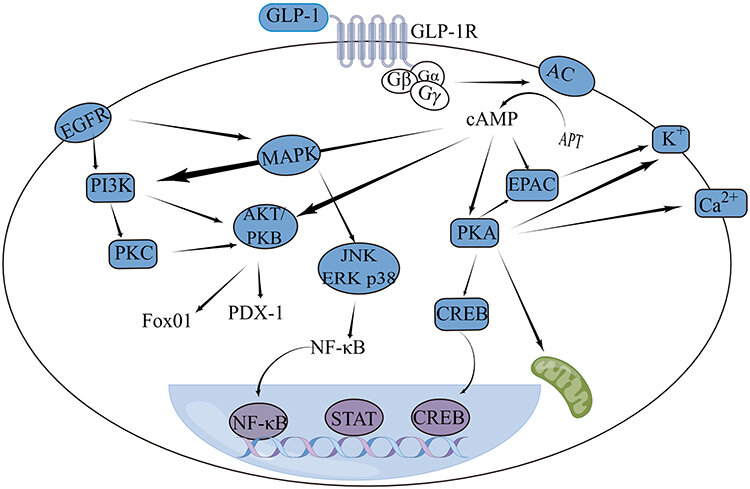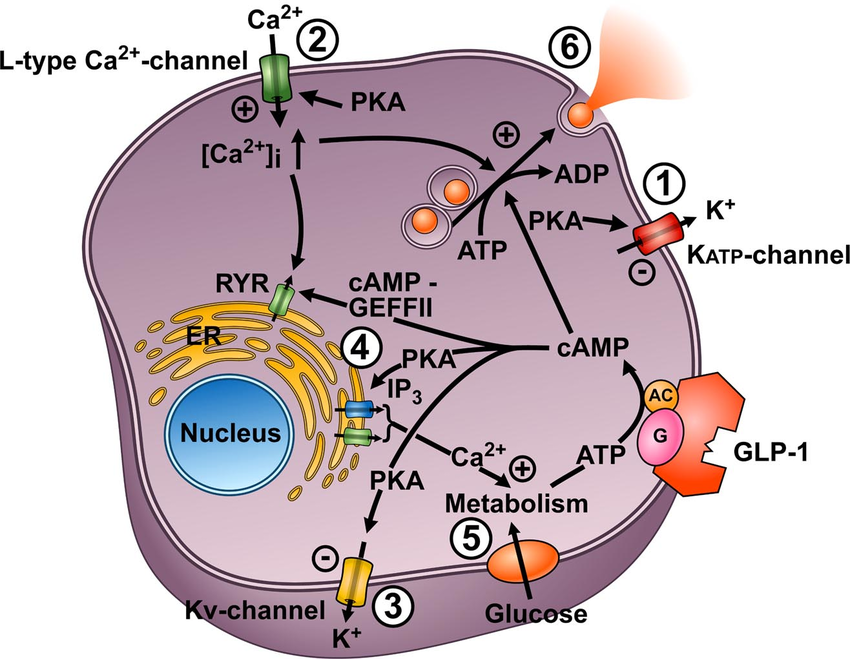Glucagon-like peptide 1 (GLP-1) is an important hormone that helps control blood sugar levels. It’s produced by L-cells found in the intestines in the distal ileum and colon as well as in the jejunum and duodenum. These L-cells are shaped like triangles and are located in the lining of the intestines, where they interact directly with nutrients, nerve signals, and hormones.

When is GLP-1 Released?
Foods that are high in protein, healthy fats and fiber can trigger the release of GLP-1. When we eat, GLP-1 is released from the L-cells in a two-phase pattern. The first phase happens quickly, about 10-15 minutes after eating, followed by a longer second phase which happens 30-60 minutes later.
The early release of GLP-1 is likely triggered by signals from the nervous system or other hormones. However, some evidence suggests that the L-cells in the upper parts of the intestines such as the jejunum are also involved in this early release due to their direct contact with food.
The second phase of GLP-1 release occurs when digested nutrients directly stimulate the L-cells. This process is influenced by the rate at which the stomach empties its contents into the small intestines. GLP-1 slows down this gastric emptying to help regulate its own secretion and ensure a steady release of nutrients.
The Signaling Pathways of GLP-1 Release
GLP-1 exists different forms in our body, mainly GLP-1(7–36)NH2, which makes up about 80% of the GLP-1 in our bloodstream. These different forms are created through various chemical changes after the hormone is made.

GLP-1 is released by cells in the gut called GLP-1 EECs. This release is triggered when we eat foods containing carbohydrates, proteins, and fats. For example, when you eat a meal, glucose (sugar), amino acids (from proteins), and fatty acids (from fats) all help to stimulate the release of GLP-1.
Glucose and Amino Acids
These nutrients enter the GLP-1 EECs through specific transporters (like SGLT), which helps them enter the cells and trigger GLP-1 release.
Healthy Fats
Fats are detected by special receptors (like GPR40, GPR120, and GPR119) on the gut cells. These receptors send signals that lead to GLP-1 release. Bile acids, released when we eat fats, also help in this process through other receptors like TGR5 and FXR.
Neural Signals
Before nutrients even reach the gut, there are signals from the vagus nerve which connect the gut to the brain that can stimulate GLP-1 release. This is why even the thought or smell of food can make you start to feel hungry or full.
GLP-1’s Impact
Once released, GLP-1 has a very short life in the blood stream, usually lasting just a few minutes. It gets broken down by an enzyme called DPP IV. This short lifespan makes it tricky for GLP-1 to stay active in the body. That’s why researchers have developed GLP-1 analogs, like Exendin-4 and Liraglutide, which are modified versions of GLP-1. They last much longer in the body and are used to help control blood sugar levels in people with diabetes.
How GLP-1 Works Inside the Cells
GLP-1 acts on cells through a protein called the GLP-1 receptor (GLP-1r). Here’s how it works human body:
When GLP-1 binds to its receptor on pancreatic cells, it activates a pathway involving a protein called Gαs. This leads to an increase in cyclic AMP (cAMP), which then activates other proteins like PKA and EPAC. These proteins help to open channels that let calcium into the cells, which in turn triggers the release of insulin.

GLP-1 also activates other pathways involving Gαq and Gαi proteins, which help in processes like increasing calcium levels inside the cells and promoting cell survival. It can also activate other receptors, such as the epidermal growth factor receptor (EGFR).
After GLP-1 binds to its receptor, the receptor is pulled into the cell through a process called internalization. This step is crucial for the regulation and desensitization of the receptor, ensuring that the cell responds appropriately to GLP-1 signals.
GLP-1 also affects the brain, helping to regulate appetite and energy balance. It acts on specific brain cells in the nucleus of the solitary tract (NST) and responds to signals from the gut and hormones like cholecystokinin (CCK) and leptin. This connection between the gut and brain is crucial for controlling hunger and satiety.
Researchers are still studying how different signals and pathways interact to regulate GLP-1 release and function.